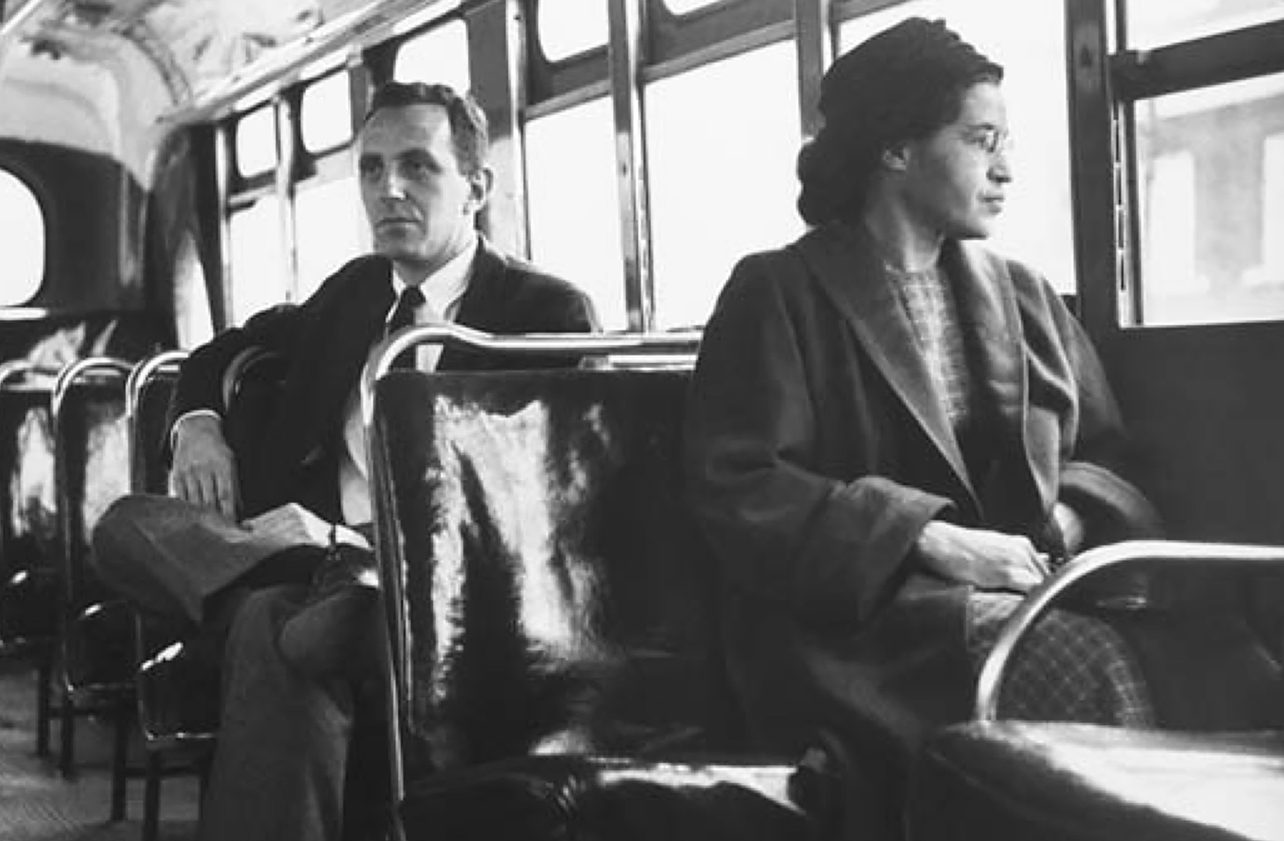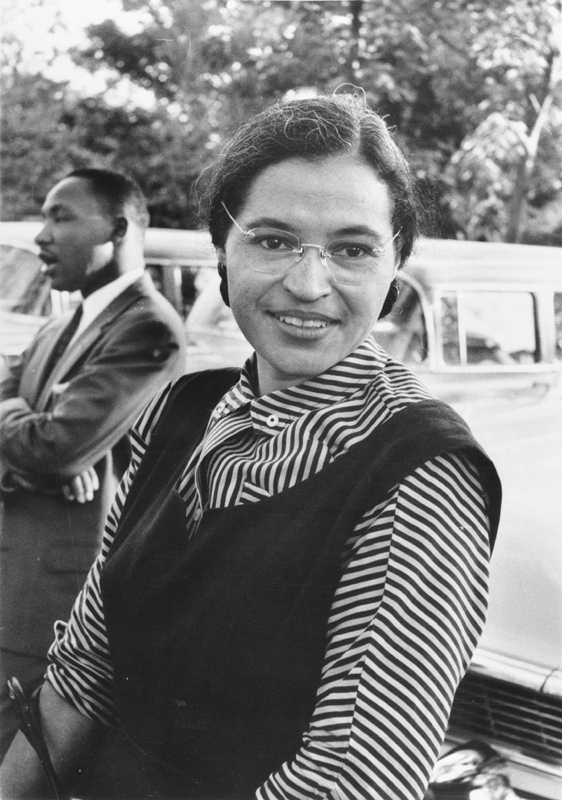Rosa Parks and the Image of Respectability
This post is part of our online roundtable on Black Women and the Politics of Respectability.

Since the day she refused to give up her seat on a bus to a White man in 1955, Rosa Parks has been an icon of the post-war Civil Rights Movement. The famous photograph showing her seated on a bus has been enthusiastically referenced by liberals, conservatives, and corporations alike as representing a kind of dissent to which everyone seems to curiously consent. A closer look at the photograph reveals a profound ambivalence: While it does invite viewers to “[t]hink different,” as one famous advertisement captioned the picture, it also uses subtle visual details to affirm the status quo.
Rosa Parks’s general popularity may well be owed to what Evelyn Brooks Higginbotham termed the “politics of respectability.” Higginbotham used this concept to describe African Americans’ strategic adherence to “the dominant society’s norms of manners and morals.” To achieve Black uplift, many leaders and activists advocated middle-class values such as traditional gender roles, hard work, thrift, cleanliness, and restrained religiosity. The politics of respectability also had a decidedly visual dimension, promoting what Jasmine Nicole Cobb describes as “a diminished Black visibility.” Rosa Parks’s classic image is a prime example of the ways in which photography has been used to construct Black respectability.
In the context of the Civil Rights Movement of the early Cold War era, the politics of respectability had both vital strategic value and detrimental effects on the imagined scope of social change. For instance, it helped build sorely needed coalitions among African Americans and many Blacks hoped that respectability would help protect them against the violent de-humanization of racism, whose sheer brutality had been exposed once again in the summer of 1955 by the cruel murder of Emmett Till. The politics of respectability also sought to convince international Cold War audiences of the worthiness of US African American protest. At the same time, it promoted normative forms of identification that often cemented class distinctions and dominant norms of gender and sexuality, muted radicalism, and silenced the voices of those who did not fit into its narrow frame.
Rosa Parks’s iconic photograph demonstrates how the movement and the White liberal media complemented non-visual strategies of respectability with a specific visual grammar. While the photograph is often taken to be a snapshot of a spontaneous act of revolt, it is actually the product of a planned photo shoot that took place on December 21, 1956, the day after the Montgomery bus system was integrated. Others, such as Claudette Colvin and Mary-Louise Smith, had carried out the same courageous act before Rosa Parks. Yet, local leaders decided not to showcase their protest, instead choosing Rosa Parks as the public face of the Montgomery boycott. Her private life was well-suited for strategies of respectability: She was married, she had done what was commonly perceived as “womanly” work by caring for her ailing mother, and her position as a seamstress, which was consistently feminized, made her appear respectable to both the working and middle classes. In an interview, Claudette Colvin also suggested that Parks’s selection may have been related to her genteel habitus and manner.

By the time the famous photograph was created over a year after Parks’s act of protest, Martin Luther King, Jr. had taken over as the public face of the movement. When photojournalists came to Montgomery to take pictures, Parks was at home caring for her mother while King and Ralph David Abernathy “made a great show of riding the first integrated bus in Montgomery,” as Parks puts it in her biography. It was the journalists who picked her up at her house and persuaded her to take pictures. It seems that Parks was rather reluctant to participate in this endeavor and just followed the journalists’ directions. In her biography, she writes that they “had [her] get on and off buses,” each time taking pictures “until they were satisfied.” We may thus assume that the photograph stages Black protest according to the rules of White liberal journalists.
At first sight, the photograph represents an act of empowerment. As Parks is seated in the front of the bus while a White man had to take place behind her, she appears to have achieved what she fought for: The rule that forced African Americans to cede their seats to White passengers has been upended. Her determined look, contained posture, and neat dress suggest strength of character and self-control. These values are pitted against White supremacy in a sentimental David-vs.-Goliath scenario that is both simplifying and persuasive: Through her own courageous act of protest, this Black woman helped end racial discrimination on public transport.
At the same time, the photograph visually tames the insurgent woman and the Black protest she represents by deferring to the norms of respectability. While Parks appears to prevail over the White man through her position in the front, her restrained posture, her position at the margin of the bus, and her look out of the window reduce the amount of space she seems to claim. Nicholas C. Criss (a UPI journalist, not a Southern segregationist, as often assumed) forms a contrast: His expansive posture and the look on his face seem to suggest that, despite his position in the rear, he still controls the interior of this bus that metaphorically represents an imagined post-integration society. The photograph’s focus, which is tellingly not on Parks but on the seat beside her, further reduces the salience and power of her visual presence and thus assures the viewer that wide-spread segregationist fears of racial “crowding” are unwarranted. Moreover, by leaving a great amount of space—almost a full, brightly lit bus window—between Parks and Criss, the photograph visually reduces the imagined physical proximity between men and women of different races and thus associations with what was called “miscegenation.” This strategy of “sexual containment” is further amplified by Parks’s restrained middle-class femininity and by the fact that Parks and Criss turn their backs to one another. By thus avoiding cultural stereotypes of Black (male) over-sexualization, the photograph strategically disentangles integration from cross-racial intimacy.

The photograph’s skin color politics are no less ambivalent. As the light shines in from the outside, Parks’s already relatively light skin is additionally whitened. In her autobiography, Parks reverently writes about her grandfather, the son of a White plantation owner, who regularly passed as White and who used the Whiteness of his skin to challenge social hierarchies based on arbitrary constructs of race. He instilled in Parks’s mother, her siblings, and their children “that you don’t put up with bad treatment from anybody.” “It was passed down almost in our genes,” Parks writes. It appears that the lightness of his skin protected Parks’s grandfather from physical punishment by Whites, just as it may have protected Parks from police violence during her arrests. While Parks’s light(ened) skin tone may be read as accommodation to colorist social hierarchies that artificially attribute value and respectability to lighter-skinned individuals, it also bespeaks the long-standing, often violent cross-racial intimacy and procreation that unearths these artificial categories of Blackness and Whiteness.
As the photograph mitigated the expression of Black revolt through visualizing gendered, racialized, and classed normativity, it presented an ideal object for mainstream appropriation. Consequently, Parks developed into the popularly best-known female face not just of the Montgomery Bus Boycott but of the Civil Rights Movement in general. In 2013, Parks became the first African American honored by a full-body statue in the Capitol’s Statuary Hall. As her statue echoes the signature pose and attire popularized by her photographs, it perpetuates the aesthetics of respectability that have helped to contain the public understanding of both her life work and of the complex coalitions that carried the Civil Rights Movement forward. A recent biography by Jeanne Theoharis vigorously emphasizes that Parks’s protest was not limited to a moment of remaining seated but that it was part of a life of, at times radical, activism. Parks served as a secretary for the NAACP and actively helped sustain the bus boycott for over a year despite death threats, economic insecurity, and health issues. Regardless of the fact that she was forced to move North on account of her activism, she continued to agitate for Black political power and against police brutality, government persecution, sexual assault, and the Vietnam War. Her work grew out of a network of (often female) activists whose public personae or visualizations may not have been as neatly compatible with mainstream notions of respectability but whose efforts were indispensable to the movement. While the image of respectability has done important work for civil rights, it is thus beyond its frame that we find a fuller understanding of the struggle for Black empowerment.
Click here to read the journal article on which this guest post is based.
Copyright © AAIHS. May not be reprinted without permission.